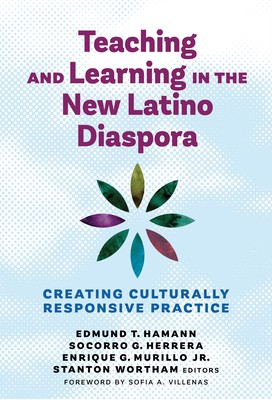
- We will send in 10–14 business days.
- Publisher: Teachers College Press
- ISBN-10: 0807767301
- ISBN-13: 9780807767306
- Format: 15.7 x 22.7 x 1.1 cm, minkšti viršeliai
- Language: English
- SAVE -10% with code: EXTRA
Teaching and Learning in the New Latino Diaspora (e-book) (used book) | bookbook.eu
Reviews
Description
This volume does more than document an educational dynamic that impacts Latino populations across the United States; it also connects educational challenges to concrete plans for how those problems can be resolved. Both experienced and new scholars describe strategies and outline policies to support academic success, affirm identity and belonging, and show how educational institutions can be transformed to better serve Latino constituencies in a post-pandemic and post-Trump world. Examples from elementary education to higher education supply familiar points of entry, but also challenge readers to explore scenarios and strategies that they have not previously considered. Each chapter begins with empirical documentation of an educational problem involving Latino populations where their presence is relatively new, and goes on to outline how that problem can be resolved. The text includes depictions of thoughtful parent-teacher partnerships, what authentically welcoming college campuses might look like, how high school literature classes could include more Latino authors, and much more.
Book Features:
- Includes detailed examples of practice to assist teachers and school leaders in restructuring their classrooms and programs to better serve Latino students.
- Describes settings and scenarios from across the United States that will be familiar to those teaching, leading, or preparing to do so.
- Focuses on the new diaspora as distinct from states with traditionally large Latino populations.
- Argues that lagging educational outcomes are not inevitable and that inclusion, engagement, and success are possible and worth striving for.
EXTRA 10 % discount with code: EXTRA
The promotion ends in 21d.07:12:57
The discount code is valid when purchasing from 10 €. Discounts do not stack.
- Publisher: Teachers College Press
- ISBN-10: 0807767301
- ISBN-13: 9780807767306
- Format: 15.7 x 22.7 x 1.1 cm, minkšti viršeliai
- Language: English English
This volume does more than document an educational dynamic that impacts Latino populations across the United States; it also connects educational challenges to concrete plans for how those problems can be resolved. Both experienced and new scholars describe strategies and outline policies to support academic success, affirm identity and belonging, and show how educational institutions can be transformed to better serve Latino constituencies in a post-pandemic and post-Trump world. Examples from elementary education to higher education supply familiar points of entry, but also challenge readers to explore scenarios and strategies that they have not previously considered. Each chapter begins with empirical documentation of an educational problem involving Latino populations where their presence is relatively new, and goes on to outline how that problem can be resolved. The text includes depictions of thoughtful parent-teacher partnerships, what authentically welcoming college campuses might look like, how high school literature classes could include more Latino authors, and much more.
Book Features:
- Includes detailed examples of practice to assist teachers and school leaders in restructuring their classrooms and programs to better serve Latino students.
- Describes settings and scenarios from across the United States that will be familiar to those teaching, leading, or preparing to do so.
- Focuses on the new diaspora as distinct from states with traditionally large Latino populations.
- Argues that lagging educational outcomes are not inevitable and that inclusion, engagement, and success are possible and worth striving for.


Reviews